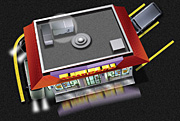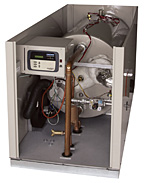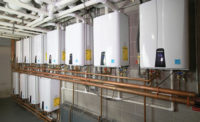Hot water is critical to the safe and sanitary operation of a foodservice establishment. In order to take full advantage of the more sophisticated cleaning and sanitizing equipment available, a commercial kitchen must have plenty of hot water.
While there are several factors that influence specifications of hot water systems in restaurants, it is often the automatic dishwashing equipment that governs the design of the entire system. Beyond the dishwashing equipment, it is critical to determine exactly how much hot water the kitchen needs to maintain high sanitary standards demanded by the North American public and local code officials. Furthermore, space is always a consideration in a commercial foodservice application.
The end-result system must accommodate the large volume of 180-degree water necessary to sanitize pots, pans and preparation areas, while providing enough 140-degree water for general purpose washing and cleaning needs. Specifiers must also consider influencing factors like the type of restaurant and the kind of food served.
Several factors are at play in this type of application, so the more you know about actual usage, the better off you'll be. An improperly sized water heating system in any restaurant can force it to close its doors.
Determine the Hot Water Load
The hot water load in a food-serving establishment is typically a high peak demand over the course of one, two or three hours. The average restaurant uses approximately 2 gallons of hot water per meal served. Approximately 60% of this total is used during the peak dishwashing period. This 60%, or 1.2 gallons per meal, is a mixture of 140-degree and 180-degree water. Of this 1.2 gallons, 60%, or .72 gallons, is 180-degree water for the automatic dishwasher and 40%, or .48 gallons, is 140-degree water.By converting the 180-degree water to an equivalent amount of 140-degree water, it is found that a total of 1.5 equivalent gallons of 140-degree water per meal is the peak demand that must be met. The hot water system must be able to accommodate the large volume of 180-degree water needed for dishwashing, while providing enough 140-degree water to maintain the high degree of sanitization necessary to meet the requirements of the industry's stringent standards.
The bottom line is that the system must be able to provide an ample supply of hot water. An undersized system will be overworked and could shorten the lifespan of the water heating equipment.

Sanitization Options
While the use of chemical sanitizers for dishwashing has grown in popularity, a kitchen that uses chemical dishwashers will have a lot of excess water on the floor around the kitchen area. Since 180-degree water evaporates faster than 140-degree water, the drying process is faster with the hotter water. Dishes rinsed in water at a lower temperature come out of the dishwasher dripping with rinse water, which then ends up on the floor in the work area.
Even the untrained eye will recognize a kitchen that uses 140-degree water in the dishwasher. Simply put, the benefits of cleaning with 180-degree, chemical-free hot water go beyond the sanitization properties. It actually makes for a cleaner kitchen to use rinse water at 180 degrees.
Chemical-Free Dishwashers
From the highest volume kitchens serving breakfast, lunch and dinner buffets at monster-sized hotels and casinos to the local sandwich joint on Main Street, there is no substitute for the sanitizing abilities of hot water. The use of hot water is recognized as the most efficient method and the most widely used in commercial kitchens. In all cases, the hot water delivery system in a commercial kitchen must provide enough 180-degree water for the automatic dishwashers, which usually have a high gallons per minute (gpm) flow rate and a relatively low gallons per hour (gph) consumption of 180-degree rinse water.A single-tank door-type washing machine would most likely be found in kitchens with low to medium hot water demand. It requires a 180-degree sanitizing rinse on an intermittent basis. Because of this intermittent operation, recirculation is important to maintain the 180-degree water temperature in the piping between the heater and the dishwasher. A machine of this type might have a 10-gpm flow rate but will consume only 90 gallons of 180-degree water per hour.
While a conveyor dishwasher, found in higher volume establishments, has a relatively low gpm flow rate, it will consume a large amount of 180-degree water in an hour with either a single or a double tank. A machine of this magnitude might have a constant flow rate of 5 gpm and could consume 300 gallons of 180-degree water per hour.
It is important to note that the 180-degree water generated by the water heating system should be connected only to the rinse inlet of the dishwasher. The pre-wash or scraping section of the dishwashing operation and the general purpose sinks throughout the kitchen usually do not need to be plumbed to receive water above 140 degrees. However, some local code regulations require one sanitization pot sink that can receive 180-degree water or one that has a built-in heat source to boost the temperature of water already in the sink.

Product Solutions
Since the floor plans of most restaurants are designed to accommodate as many diners as possible, specifiers can arrive at unique design solutions by incorporating space-saving products. Some of the most innovative manufacturers have developed water heater solutions that free up space by moving the unit outside. An outdoor installation eliminates the need to include a water heater and its venting in the designs for the restaurant interior.In some cases, a booster heater must be factored into the equation in order to provide enough 180-degree rinse water for the dishwasher. The factors that govern the choice of equipment are the gpm flow rate and gph consumption rate of the dishwasher. While there are a variety of traditional under-the-counter electric booster heaters sized for most commercial dishwashers on the market today, other options are also available.
One option is to use a copper heat exchanger heater as a booster heater. This solution requires that you match the gpm delivery rate of the heat exchanger against the gpm requirements of the dishwasher. When used in this application, recirculation is accomplished by pump, and a flow switch should be installed in the 180-degree line. There is no storage capacity with this type of heater, and it heats only as the water flows through it. This solution will provide up to a 60-degree rise through the heater and is well-suited for applications where conveyor type dishwashers are used.
The second option is to use a tank-type water heater as the booster. When a tank-type water heater is incorporated in the system, recirculation (when necessary) may be accomplished by a recirculating pump. Some of the more advanced commercial tank-type water heaters offer thermal efficiencies up to 98%, with a variety of venting options to make the best use of available floor space. If one of the heaters in a multiple system is used as a booster heater, it must be sized to supply the expected gpm at the desired temperature rise to satisfy the dishwasher requirements.
In all cases, the National Sanitation Foundation (NSF) recommends a recirculation of 180-degree water for any installation where the dishwasher is more than five feet from the water heater.

Other Considerations
Restaurants that serve a dine-in crowd for breakfast, lunch and dinner have vastly different hot water needs than a fast food or "paper"An Ounce of Prevention
Since an interruption in hot water delivery can cripple a foodservice establishment, specifiers should consider building some level of redundancy into the system. In other words, under normal circumstances the establishment will have two water heaters working together to provide enough hot water for dishwashing, while also producing hot water for general use. If the hot water supply from one heater is interrupted, there will still be a back-up unit that can produce the required hot water.Every installation needs to be approached independently. Some restaurants are not willing to take up the floor space required for two tank-type water heaters. Some simply don't have the space to give up. It is important to consider the impact of emergency repair/replacement costs on the customer.
In the end, a specifier's most important job is to provide the right recommendation to meet the specific needs of each customer. While your first priority is to keep the customers out of hot water, the trick is to keep them in hot water without interruption!
